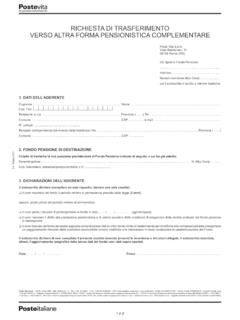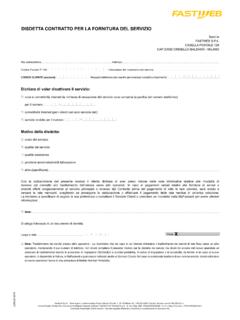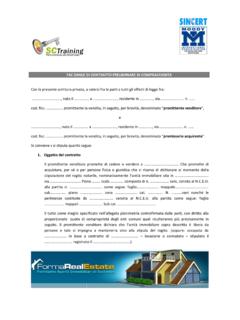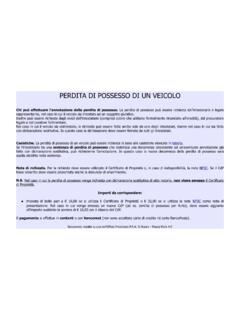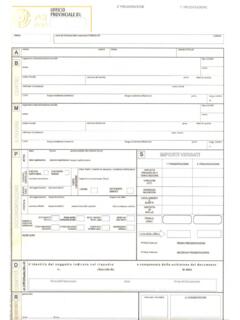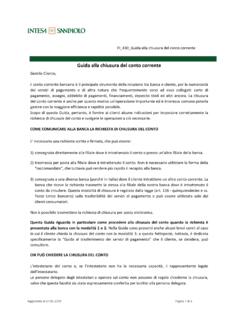Transcription of Transfer Learning - University of Wisconsin–Madison
1 Transfer LearningLisa Torrey and Jude ShavlikUniversity of Wisconsin, Madison WI, Learning is the improvement of Learning in a newtask through the Transfer of knowledge from a related task that has al-ready been learned. While most machine Learning algorithms are designedto address single tasks, the development of algorithms that facilitatetransfer Learning is a topic of ongoing interest in the machine-learningcommunity. This chapter provides an introduction to the goals, formu-lations, and challenges of Transfer Learning . It surveys current researchin this area, giving an overview of the state of the art and outlining theopen problems. The survey covers Transfer in both inductive Learning andreinforcement Learning , and discusses the issues of negative Transfer andtask mapping in learners appear to have inherent ways to Transfer knowledge betweentasks.
2 That is, we recognize and apply relevant knowledge from previous learningexperiences when we encounter new tasks. The more related a new task is to ourprevious experience, the more easily we can master machine Learning algorithms, in contrast, traditionally addressiso-lated learningattempts to change this by developing methodsto Transfer knowledge learned in one or moresource tasksand use it to improvelearning in a relatedtarget task(see Figure 1). Techniques that enable knowl-edge Transfer represent progress towards making machine Learning as efficient ashuman chapter provides an introduction to the goals, formulations, and chal-lenges of Transfer Learning . It surveys current research in this area, giving anoverview of the state of the art and outlining the open methods tend to be highly dependent on the machine Learning al-gorithms being used to learn the tasks, and can often simply be consideredextensions of those algorithms.
3 Some work in Transfer Learning is in the contextof inductive Learning , and involves extending well-known classification and infer-ence algorithms such as neural networks, Bayesian networks, and Markov LogicNetworks. Another major area is in the context of reinforcement Learning , andinvolves extending algorithms such as Q- Learning and policy search. This chaptersurveys these areas in theHandbook of Research on Machine Learning Applications, publishedby IGI Global, edited by E. Soria, J. Martin, R. Magdalena, M. Martinez , TaskFig. Learning is machine Learning with an additional source of informationapart from the standard training data: knowledge from one or more related goal of Transfer Learning is to improve Learning in the target task byleveraging knowledge from the source task.
4 There are three common measures bywhich Transfer might improve Learning . First is the initial performance achievablein the target task using only the transferred knowledge, before any further learn-ing is done, compared to the initial performance of an ignorant agent. Second isthe amount of time it takes to fully learn the target task given the transferredknowledge compared to the amount of time to learn it from scratch. Third is thefinal performance level achievable in the target task compared to the final levelwithout Transfer . Figure 2 illustrates these three a Transfer method actually decreases performance, thennegative transferhas occurred. One of the major challenges in developing Transfer methods isto produce positive Transfer between appropriately related tasks while avoidingnegative Transfer between tasks that are less related.
5 A section of this chapterdiscusses approaches for avoiding negative an agent applies knowledge from one task in another, it is often nec-essary to map the characteristics of one task onto those of the other to specifycorrespondences. In much of the work on Transfer Learning , a human providesthismapping, but some methods provide ways to perform the mapping auto-matically. Another section of the chapter discusses work in this transferwithout transferhigher starthigher slopehigher asymptoteFig. ways in which Transfer might improve TaskTarget TaskTask 1 Task 2 Task 3 Task 4 Transfer LearningMulti-task LearningFig. we define Transfer Learning , the information flows in one direction only, fromthe source task to the target task. In multi-task Learning , information can flow freelyamong all will make a distinction between Transfer Learning andmulti-task learn-ing[5], in which several tasks are learned simultaneously (see Figure 3).
6 Multi-task Learning is clearly closely related to Transfer , but it does not involve des-ignated source and target tasks; instead the Learning agent receives informationabout several tasks at once. In contrast, by our definition of Transfer Learning ,the agent knows nothing about a target task (or even that there will be a targettask) when it learns a source task. It may be possible to approach a multi-tasklearning problem with a Transfer - Learning method, but the reverse is not possi-ble. It is useful to make this distinction because a Learning agent in a real-worldsetting is more likely to encounter Transfer scenarios than multi-task IN INDUCTIVE LEARNINGIn an inductive Learning task, the objective is to induce a predictive model from aset of training examples [28]. Often the goal is classification, assigningclass la-bels to examples.
7 Examples of classification systems are artificial neural networksand symbolic rule-learners. Another type of inductive Learning involves model-ing probability distributions over interrelated variables, usually with graphicalmodels. Examples of these systems are Bayesian networks and Markov LogicNetworks [34].The predictive model learned by an inductive Learning algorithm should makeaccurate predictions not just on the training examples, but also on future exam-ples that come from the same distribution. In order to produce a model with thisgeneralization capability, a Learning algorithm must have aninductive bias[28] a set of assumptions about the true distribution of the training bias of an algorithm is often based on thehypothesis spaceof possiblemodels that it considers. For example, the hypothesis space of the Naive Bayesmodel is limited by the assumption that example characteristics are condition-ally independent given the class of an example.
8 The bias of an algorithm can alsobe determined by its search process through the hypothesis space, which deter-mines the order in which hypotheses are considered. For example, rule-learningalgorithms typically construct rules one predicate at a time, which reflects the3assumption that predicates contribute significantly to example coverage by them-selves rather than in pairs or in inductive Learning works by allowing source-task knowledge toaffect the target task s inductive bias. It is usually concerned with improvingthe speed with which a model is learned, or with improving its generalizationcapability. The next subsection discusses inductive Transfer , and the followingones elaborate on three specific settings for inductive is some related work that is not discussed here because it specificallyaddresses multi-task Learning .
9 For example, Niculescu-Mizil and Caruana [29]learn Bayesian networks simultaneously for multiple related tasks by biasinglearning toward similar structures for each task. While this is clearly related totransfer Learning , it is not directly applicable to the scenario in which a targettask is encountered after one or more source tasks have already been TransferIninductive transfermethods, the target-task inductive bias is chosen or adjustedbased on the source-task knowledge (see Figure 4). The way this is done variesdepending on which inductive Learning algorithm is used to learn the sourceand target tasks. Some Transfer methods narrow the hypothesis space, limitingthe possible models, or remove search steps from consideration. Other methodsbroaden the space, allowing the search to discover more complex models, or addnew search [2] frames the Transfer problem as that of choosing one hypothesisspace from a family of spaces.
10 By solving a set of related source tasks in eachhypothesis space of the family and determining which one produces the bestoverall generalization error, he selects the most promising space in the family fora target task. Baxter s work, unlike most in Transfer Learning , includes theoreti-cal as well as experimental results. He derives bounds on the number of sourcetasks and examples needed to learn an inductive bias, and on the generaliza-tion capability of a target-task solution given the number of source tasksandexamples in each HypothesesAllowed HypothesesInductive LearningSearchInductive TransferAll HypothesesAllowed HypothesesSearchFig. Learning can be viewed as a directed search through a specified hy-pothesis space [28]. Inductive Transfer uses source-task knowledgeto adjust the induc-tive bias, which could involve changing the hypothesis space or the search and Mitchell [55] look at solving Boolean classification tasks in alifelong- Learning framework, where an agent encounters a collection of relatedproblems over its lifetime.
